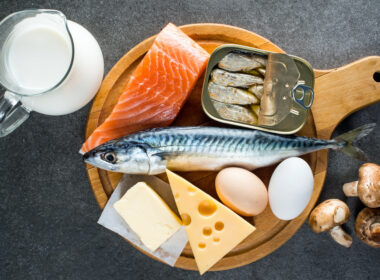Estetrol: They’re calling it “the future of the Pill.” But how could this steroid once deemed to be a “weak estrogen,” –and which is only naturally produced by the livers of babies in utero–end up as a main ingredient in the latest formulation of hormonal birth control? And is there any truth to the claim that contraceptives containing estetrol are “more environmentally friendly” than the typical Pill and other drugs containing different synthetic estrogens?
What is estetrol (E4)?
The human body can produce four types of estrogen (estriol, estrone, estradiol, and estetrol), and one of those is made only by babies in utero. According to this textbook, “Estetrol is a unique human pregnancy hormone produced by the fetal liver early during pregnancy and found in the mother at exponentially growing concentrations during gestation, with fetal levels about 10 times higher than maternal levels” [1].
While estetrol was first discovered in 1965, more research into it was largely abandoned for nearly four decades after it was pronounced a “weak estrogen” [2]. Even now, estetrol’s (E4) specific function(s) for mom or baby are still poorly understood. In general, estetrol levels are considered an indicator of fetoplacental (baby and placenta) health, such that falling maternal serum levels (measured through a blood draw) of estetrol or estriol (another estrogen, produced by the placenta) are troubling, and suggestive of a problem with the baby and/or the placenta.
Which contraceptives use E4, and why does it matter?
In 2021, a hormonal contraceptive combination of the progestin drospirenone and estetrol (trade name Nextstellis) received FDA approval. While drospirenone is nothing new (it’s the same synthetic progestin found in “Yaz” or “Yasmin” birth control pills), the introduction of estetrol in combination with drospirenone caused a stir. That’s because, historically, adjustments to “the Pill” have revolved around switching up the type of progestin used, or decreasing the amount of synthetic estrogen in an effort to minimize side effects. But birth control containing estetrol is novel because estetrol is a different type of estrogen altogether.
Furthermore, E4 appears to be particularly effective at preventing pregnancy. Like conventional hormonal birth control, Nextstellis works in three ways: by preventing ovulation, negatively impacting sperm motility (via thickening of the woman’s cervical mucus), and thinning the endometrial lining (to prevent implantation, should ovulation and conception still manage to occur). While the typical combined oral contraceptive pill is 99% effective with perfect use and 91% effective with typical use, in a 12-month,13-cycle research trial of over 1,800 women, Nextstellis was more than 98% effective at preventing pregnancy with perfect use and more than 97% effective with typical use [3].
Side effects of estetrol (E4) vs. ethinylestradiol (EE2)
Conventional hormonal birth control contains ethinylestradiol (EE2), the synthetic version of estradiol associated with increased risk for blood clots and other potentially serious (or even fatal) vascular problems, like heart attacks or strokes. As mentioned above, Nexstellis utilizes estetrol instead of ethinylestradiol, which is considered less likely to cause these types of problems, and why it is therefore being labeled as safer for women to take.
Why might estetrol cause fewer troublesome side effects than typical formulations of the Pill? Estetrol is called the first Native Estrogen with Selective actions in Tissues (NEST), because it binds selectively to some, but not all of the same estrogen receptors in the body as ethinylestradiol does. For example, both estetrol and ethinylestradiol bind to estrogen receptors in the liver and in bone, but estetrol also binds in a targeted way to receptors in the uterus, while ethinylestradiol does not. And while ethinylestradiol binds to receptors in the breast, leading to rapid cell growth (read: potential places for cancer to start), estetrol does so to a much lesser extent. Early research in animals corroborated this, finding that E4 has much less impact on breast tissue compared to EE2 [2]. The selective binding explains why E4 is thought to have fewer androgenic (male hormone) side effects like increased body hair, acne, decreased sex drive, and mood swings compared to EE2.
Is birth control containing estetrol environmentally friendly?
Estetrol may be less toxic to the environment compared to ethinylestradiol. First, it’s true that estetrol is “plant-based” or derived from plant sources. Still, it goes through a multistep production process in a lab to be usable in Nextstellis, just like EE2 does to be used in other forms of hormonal birth control. Second, it’s also true that E4 lasts much longer in the body than EE2. How does this translate to environmental friendliness? Because E4 is more stable than EE2, i.e. has a longer half-life, it does not break down rapidly and get peed out (eventually polluting the waterways) to nearly the same extent. In a safety study, only scant amounts of biologically active E4 were detectable in women’s urine, and researchers found “E4 does not accumulate in living organisms and is likely to dissipate rapidly from water and sediment.”
Natural Womanhood has reported several times on the environmental unfriendliness of EE2-containing hormonal birth control, especially its concerning impacts of feminizing fish and decreasing sperm counts due to tainted water sources (since water treatment facilities don’t have the capability to adequately filter out the estrogen and progestin metabolites).
While mainstream media has previously shied away from admitting the environmental havoc wreaked by synthetic estrogen, a press release touting estetrol’s environmental friendliness openly acknowledged that “EE2 is a synthetic estrogen, designed to be resistant to degradation and inactivation. It was intended to have comparable biological activities as [natural estradiol] E2, but more persistent due to its stability in the human body. Because of these properties, EE2 persists longer and accumulates more in the environment than natural estrogens….EE2 is considered to be a strong environmental endocrine disruptor which accumulates in living organisms impacting ecosystems.”
The negative effects of EE2 in fish include “reduced egg production, reduced testicular growth, delayed maturation, development of ova-testes in males and development of the populations with skewed female to male ratios (i.e. feminization).” In contrast, only scant amounts of ingested E4 were measured in study subjects’ urine, and E4 was not found to have the negative reproductive effects of EE2 on other aquatic organisms.
Separating reality from hype
A goodRx review of estetrol praised “the first new estrogen approved by the FDA in 50 years.” Nextstellis’ website touts decreased rates of breakthrough bleeding amongst research study participants compared to other forms of hormonal birth control, as well as decreased negative effects on liver function.
All the same, the product label reads very similarly to those of other hormonal birth control products. A warning at the top of the Nextstellis product insert reads “Females over 35 years old who smoke should not use NEXTSTELLIS (4) Cigarette smoking increases the risk of serious cardiovascular events from combination oral contraceptive (COC) use. (4)” Nextstellis is contraindicated in any woman with a high risk for arterial or venous blood clots, or with current or past breast cancer, liver problems, kidney problems, adrenal insufficiency, and/or abnormal uterine bleeding without a known cause.
In research studies, nearly 10% of women discontinued Nextstellis, and 58% of all women reported at least one of the following:
- 9-10% reported mood disturbances (defined as “adjustment disorder, affective disorder, agitation, anger, anxiety, depressed mood, depression, depressive symptom, disorientation, emotional disorder, emotional distress, euphoric mood, generalized anxiety disorder, insomnia, irritability, mood altered, mood swings, nervousness, panic attack, panic disorder, performance fear, restlessness, sleep disorder, stress, suicidal ideation, tearfulness”)
- 9-11% reported bleeding irregularities
- 5% had breast symptoms
- 4-6% had headache
- 3-4% had painful periods
- 3% suffered weight gain
- 3% developed new or worsening acne.
The product label further contains warnings about gallbladder disease, migraines, high blood pressure, high potassium levels, and more.
Due to its relatively recent introduction to the market, Nextstellis will require much more research before it can be determined whether it lives up to the hype of causing fewer side effects in users than EE2-containing hormonal birth control. Certainly, the fact that Nexstellis (like Yaz) also contains drospirenone, which the FDA reports may carry increased blood clot risks when compared to other progestins, is concerning.
The bottom line
Estetrol’s impacts in the body may well have fewer negative effects on the environment, and its selective receptor binding may lead, as predicted, to fewer side effects compared to other forms of hormonal birth control. Regardless, the estetrol found in Nexstellis is still synthetic, derived from plant sources and designed in a lab to mimic natural estetrol, and as such comes with risks. And, it should be noted, that even if Nexstellis does prove to be slightly more tolerable for more women, it will still carry more risks and side effects than natural pregnancy prevention methods like fertility awareness, which teach women to work with their cycles, instead of shutting them down (as all hormonal methods–including Nexstellis–do).
References:
[1] Lobo, Rogerio A. Treatment of the Postmenopausal Woman: Basic and Clinical Aspects. Academic Press, 2007. [2] Grandi, Giovanni et al. “Estetrol (E4): the new estrogenic component of combined oral contraceptives”, Expert Review of Clinical Pharmacology, vol. 13: no.4 (2020) : pp. 327-30, DOI: 10.1080/17512433.2020.1750365 [3] Creinin, Mitchell D et al. “Estetrol-drospirenone combination oral contraceptive: North American phase 3 efficacy and safety results.” Contraception vol. 104,3 (2021): 222-228. doi:10.1016/j.contraception.2021.05.002Additional Reading:
3 simple tips to limit endocrine disruptors and balance hormones naturally
If we’re concerned about BPA, we should definitely be concerned about hormonal birth control
Blood clots and hormonal birth control
“No adverse outcomes?”: Debunking the bad science on birth control risks







